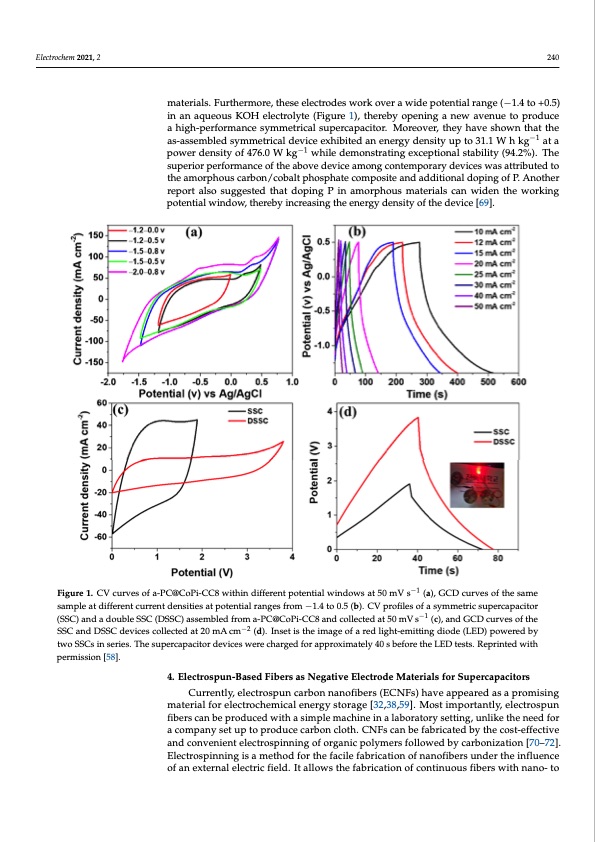
PDF Publication Title:
Text from PDF Page: 005
Electrochem 2021, 2 240 materials. Furthermore, these electrodes work over a wide potential range (−1.4 to +0.5) in an aqueous KOH electrolyte (Figure 1), thereby opening a new avenue to produce a high-performance symmetrical supercapacitor. Moreover, they have shown that the as-assembled symmetrical device exhibited an energy density up to 31.1 W h kg−1 at a power density of 476.0 W kg−1 while demonstrating exceptional stability (94.2%). The superior performance of the above device among contemporary devices was attributed to the amorphous carbon/cobalt phosphate composite and additional doping of P. Another Electrochem 2021, 2, FOR PEER REVIEW 5 report also suggested that doping P in amorphous materials can widen the working potential window, thereby increasing the energy density of the device [69]. −1 Figure 1. CV curves of a-PC@CoPi-CC8 within different potential windows at 50 mV ss (a),, GCD curves of the same sample at different current densities at potential ranges from −1.4 to 0.5 (b). CV profiles of a symmetric supercapacitor sample at different current densities at potential ranges from −1.4 to 0.5 (b). CV profiles of a symmetric supercapacitor (SSC) and a double SSC (DSSC) assembled from a-PC@CoPi-CC8 and collected at 50 mV s−1 (c), and GCD curves of the (SSC) and a double SSC (DSSC) assembled from a-PC@CoPi-CC8 and collected at 50 mV s −1 (c), and GCD curves of the −2 SSC and DSSC devices collected at 20 mA cm −(2d). Inset is the image of a red light-emitting diode (LED) powered by two SSC and DSSC devices collected at 20 mA cm (d). Inset is the image of a red light-emitting diode (LED) powered by SSCs in series. The supercapacitor devices were charged for approximately 40 s before the LED tests. Reprinted with two SSCs in series. The supercapacitor devices were charged for approximately 40 s before the LED tests. Reprinted with permission [58]. permission [58]. 4. Electrospun-Based Fibers as Negative Electrode Materials for Supercapacitors 4. Electrospun-Based Fibers as Negative Electrode Materials for Supercapacitors Currently, electrospun carbon nanofibers (ECNFs) have appeared as a promising ma- Currently, electrospun carbon nanofibers (ECNFs) have appeared as a promising terial for electrochemical energy storage [32,38,59]. Most importantly, electrospun fibers material for electrochemical energy storage [32,38,59]. Most importantly, electrospun can be produced with a simple machine in a laboratory setting, unlike the need for a com- fibers can be produced with a simple machine in a laboratory setting, unlike the need for paacnoymspeatnuypsetot upprotdoupcreodcaurcbeocnarcblotnh.clCoNthF.sCcNanFsbceanfaberifcabterdicabtyedthbeyctohset-ceoffset-cetifvfectainvde caonndvceonnievnetneielenctreolespctirnonsipnignnoifnogrgoafnoircgpaonliycmpeorlys mfoellroswfoeldlobwyecdarbbyocnaizrbatoinoinza[7ti0o–n72[]7.0E–l7e2c]-. tErloescptirnonspiningnisinagmiseathmodetfhoordthfoerfathcielefafcaiblreicfabtiroincaotfionanofofnibanerosfiubnedrserutnhdeeirntfhlueeincfeluoefnacne eoxftaenrneaxltelrencatlrieclefcietlrdic. fIiteladll.oIwt aslltohwe sfatbhreicfatbiorincaotifocnoonfticnounotuinsufoibuesrsfibweirtshwniatnhon-atnoom- tio- croscale diameters [73–75]. In 1887, C. V. Boys showed that fibers could be produced from a viscoelastic liquid in the presence of an external electric field [76]. In 1902, J. F. Cooley and J. Martin filed patents for a prototype setup for electrospinning [71]. In 1964–1969, Geoffery Taylor reported a mathematical model for the formation of a Taylor cone from a spherical solution droplet under the influence of an external electrical field [77–79]. After the 1990s, various organic polymers were demonstrated to form nanofibers, and, after thePDF Image | Review of Electrospun Carbon Nanofiber-Based Negative Electrode Materials

PDF Search Title:
Review of Electrospun Carbon Nanofiber-Based Negative Electrode MaterialsOriginal File Name Searched:
A_Review_of_Electrospun_Carbon_Nanofiber-Based_Neg.pdfDIY PDF Search: Google It | Yahoo | Bing
Sulfur Deposition on Carbon Nanofibers using Supercritical CO2 Sulfur Deposition on Carbon Nanofibers using Supercritical CO2. Gamma sulfur also known as mother of pearl sulfur and nacreous sulfur... More Info
CO2 Organic Rankine Cycle Experimenter Platform The supercritical CO2 phase change system is both a heat pump and organic rankine cycle which can be used for those purposes and as a supercritical extractor for advanced subcritical and supercritical extraction technology. Uses include producing nanoparticles, precious metal CO2 extraction, lithium battery recycling, and other applications... More Info
| CONTACT TEL: 608-238-6001 Email: greg@infinityturbine.com | RSS | AMP |